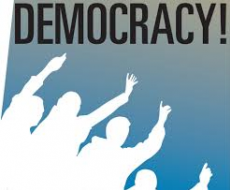
Email: ZYVC057@live.rhul.ac.uk
Total Article : 213
About Me:I'm a graduate student studying International Criminal Law and first started writing for King's News almost 4 years ago! My hobbies include reading, travelling and charity work. I cover many categories but my favourite articles to write are about mysteries of the ancient world, interesting places to visit, the Italian language and animals!

In the world of politics there is no concept that has been stretched as much as that of democracy. After Hitler gained power through a democratic system in the 1900s many became sceptic on just how much freedom democracy actually provides. I find that the British Prime Minister during WW2, Winston Churchill, expresses this sentiment sincerely when he states that “many forms of government have been tried… democracy is the worst form of government except all other forms of government”. This article will help you understand the concept of democracy and its main features so then you can decide for yourself whether Churchill was right or not!
Democracy literally means rule of the people as it derives from the Greek words ‘demos’ (people and ‘kratos’ (rule). It is the form of government that is based on political equality, this means citizens elect representatives so they can influence government output through the political system. There are two main types of democracy which each have specific characteristics, that is direct or radical democracy and representative democracy. Both allow people’s views to be part of the nation’s politics but they differ in how they reach this objective.
Direct democracy:
Direct democracy allows people to make unmediated influences on political policies; this means people can participate directly and make decisions without going through others first. Direct democracy is not a predominant form of government in the world today as the larger the number of citizens the harder it is for everyone to have a say in political affairs. It requires relatively small geographical areas, for example Athens in 500BC. Direct democracy can be asserted through various institutional forms such as:
Referendums: a direct vote in which citizens are asked to vote on a proposal and their decision is binding;
Plebiscites: similar to a referendum but is commonly used when a change in sovereignty is proposed, it was popular during the French Revolution for example;
Initiatives: the capability to initiate or pass things directly.
Representative democracy:
Representative democracy allows citizens to elect representatives, or policy makers that best share their views, and to promote those programmes that are in the individual’s interest; these representatives can then be held accountable if they aren’t acting as they should. The representative democratic form of government emerged when many believed direct democracy was unrealistic and would result in anarchy (chaos, a lack of any order).
The only country in Europe closest to being a direct democracy is Switzerland whereas many countries find themselves somewhere midway between the two poles of democracy . Which form of democracy do you think is best? Comment below!
IMAGE: http://blogs.thenews.com.pk/blogs/wp-content/uploads/2013/01/democ.jpeg

0 Comment:
Be the first one to comment on this article.